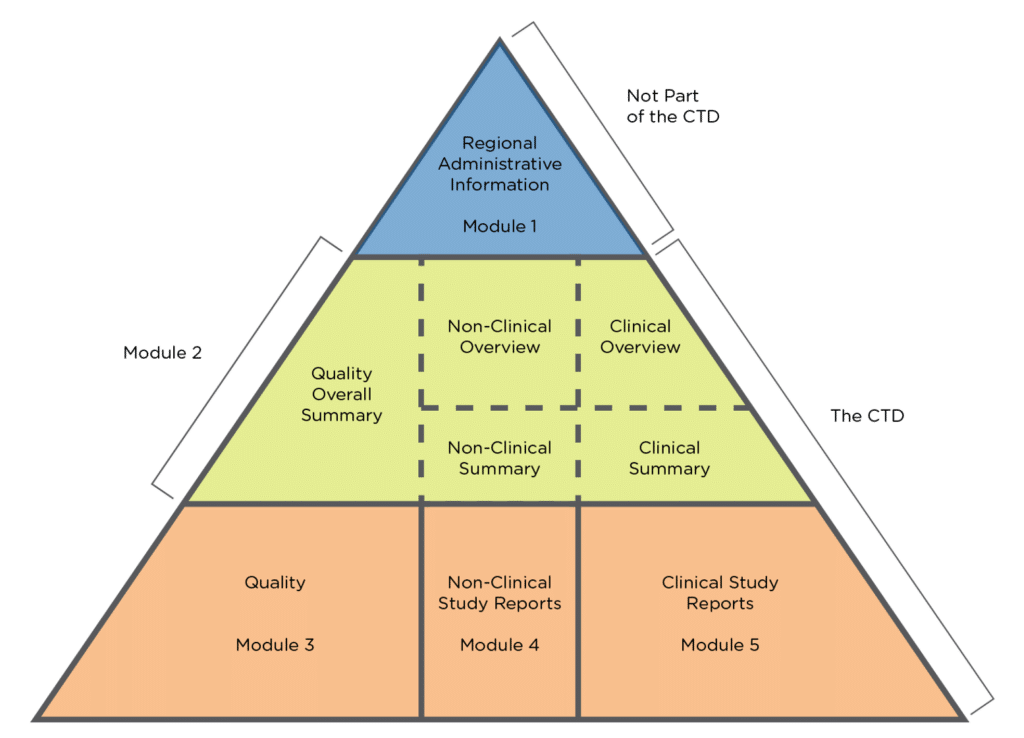New Drug Development: Mastering the Modules of the Common Technical Document
For developers of new drugs, the Common Technical Document (CTD) is the cornerstone of an Investigational New Drug Application (IND). The CTD is designed to harmonize the submission of data and information to regulatory agencies, reducing the time and resources needed to compile applications for registration of pharmaceuticals for human use. Understanding the structure, format, and requirements of the CTD is critical for preparing a successful IND and building a dossier to support a New Drug Application (NDA) submission.
What is the CTD?
Developed by the International Conference on Harmonization (ICH) in collaboration with the U.S. Food and Drug Administration (FDA), European Medicines Agency (EMA), and the Ministry of Health, Labour and Welfare in Japan, the CTD is an internationally agreed-upon format for regulatory submissions in participating countries.
In some participating countries, use of the CTD is only required for marketing applications. In the US, however, the FDA requires that all sponsors, except academic institutions, submit the CTD as part of an IND. The FDA also requires that all of the following submission types be submitted in electronic CTD (eCTD) format through its Electronic Submissions Gateway (ESG):[i]
- Commercial INDs
- NDAs
- Abbreviated NDAs (ANDAs)
- Biologics License Applications (BLAs)
- All subsequent submissions to these types of applications, including amendments, supplements, and reports
- Master files, such as Drug Master Files (DMFs)
Components of the CTD Triangle
CTDs are divided into five distinct modules, as shown in the CTD Triangle below.
Figure 1. CTD Triangle

Module 1
This module, which contains region-specific administrative and prescribing information, is not technically part of the categorical CTD sections. The regulatory authority to which the dossier is being submitted specifies the content and format of this module, which also includes a table of contents of the submission.
Module 2
This module begins with a one-page general introduction to the product and comprises summaries and overviews of the quality, nonclinical, and clinical sections of the CTD. Generally, this module is written last.
Module 3
This module provides information related to the quality of the pharmaceutical substance and product, including information on the manufacturer and chemistry, manufacturing, and controls (CMC).
Module 4
This module details safety information, including toxicology, pharmacology, and pharmacokinetic evaluations. Typically, this information is provided in the form of publications and study reports. Of note, nonclinical study reports must include full data sets, which must be provided in a standard format called Standard for Exchange of Nonclinical Data (SEND). The FDA has begun enforcing the requirement for SEND data sets, and the absence of these data sets results in a technical rejection where the IND will not be sent for review.
Module 5
This module contains efficacy data, study reports, and clinical study data, including the proposed trial protocol. It should also include supporting publications.
Evolution of the CTD from IND to NDA
Following submission of the IND and receipt of a Study May Proceed letter, the CTD becomes the basis of the dossier needed for an NDA submission. Any amendments or updates to the IND will continue to build out the CTD.
Guidance on preparing the CTD
The FDA has issued a series of guidances that provide recommendations for applicants who are preparing CTDs, including M4 Organization of the Common Technical for the Registration of Pharmaceuticals for Human Use. The agency has also published guidance on providing submissions using eCTD specifications. Sponsors may benefit from partnering with an expert like Premier Consulting, who understands the structure and publication requirements for eCTD submissions.
To learn more about the regulatory aspect of new drug development, read our guide to Succeeding with the FDA: Answers to 7 Common Questions About IND Submissions.
[i] U. S. Food and Drug Administration. eCTD Submission Requirements: What You Need to Know. Available at https://www.fda.gov/files/drugs/published/eCTD-Submission-Requirements–What-You-Need-to-Know.PDF.